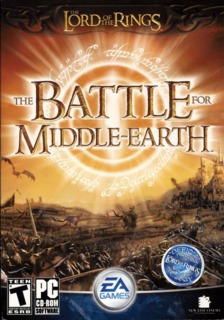The amazing world of Tolkien in RTS mode.A great looking RTS game!
The "Good Campaign" allows you to control the armies of Rohan and Gondor in an attempt to destroy the One Ring. Occasionally, you'll have some missions where you just control the Fellowship of the Ring or some of its members. The members of the Fellowship can also be seen during some of the other battles. They are usually the strongest on the battlefield and are considered to be heroes. However, these heroes can be killed, and this is where a certain flaw seems to appear in the gameplay. If you kill a hero in an earlier battle, he may still appear in a later battle. Obviously this is to preserve the storyline of the game, but it does take the realism down a notch. If you do find that one of your heroes has been killed, all you have to do is just simply click on your main Citadel building and wait for him to be revived. Some of the heroes in this campaign are Gandalf, Gimli, Legolas, Aragorn, Frodo and many more. Heroes start at level 1, but can later upgrade to a maximum of level 10 making them more powerful. You'll can also fight in large battles such as Helm's Deep and Minas Tirith. The "Evil Campaign" allows you to take control of the evil forces of Mordor and Isengard. This gives you the opportunity to finally crush those tricksey Hobbitses. That's right, there's nothing like delivering a little bit of death and destruction to the lands of Middle-Earth. Some of the heroes that you control in this campaign include Saruman and the Nazgul. Obviously your heroes have more destructive powers on the side of evil. Also playing in this campaign, you can rely more heavily on your large number of Orc armies as opposed to being outnumbered and trying to survive in the "Good Campaign". This is just one way that both campaigns differ from each other in terms of gameplay.
Another main point that is different is the use of buildings. Buildings can always be built in the area of your bases on the Combat screen. The Combat screen is where you spend the majority of the game building, recruiting, and fighting the battles of Middle-Earth. In order to build a certain building, you must first capture a predetermined plot of land on the map. This spot can then either be constructed into a base or a resource building. Bases are constructed with a Citadel building in the middle that serves as the main building of the base, and must not be destroyed or else you will lose that base. Around the Citadel, are specific plots of land where you can build buildings such as archeries, stables and barracks for recruiting troops on the side of good. The side of evil allows you to create Orc and Troll pits for the creation of troops. Both sides have specific buildings to collect resources with farms being on the good side and slaughter houses and furnaces on the evil side. Much like any RTS, resources are needed to construct more buildings and troops. Both sides can also construct certain buildings that allow for upgrading armor and weapons. Even the buildings themselves can be upgraded to create more powerful troops.
Another area of the game that you'll spend very little time in is the overall Map area of Middle-Earth. The map shows the whole land of Middle-Earth and the positions of armies around the lands. From here, you can get the overall look of this world. The game also sends you in a specific direction, albeit a very linear one, from here. The game will force you to fight certain battles and to engage in certain missions. Only occasionally will it allow you to choose certain battles in whatever order you decide to fight them. This was obviously done to coincide with the events of the movies and to make sure that nothing was out of place. However, this does create a very linear way of playing the game, since you are told where to fight. Once you are given, or sometimes choose, where to fight, your view will zoom into the Combat screen where you can start fully playing the game. Upon conquering the areas in the Combat screen, you will see the lands that you have conquered turn your colour on the Map screen. Also, conquering certain lands will either gain you new troops and allies or command and power points. Another interesting factor is that when you create your troops on the Combat screen, they can be upgraded through fighting many battles or by giving them heavier armoir or banner upgrades.
Fighting out the battles isn't very different from any other RTS. Simply clicking on a squad of troops and commanding them to attack an enemy squad will initiate a battle. They will fight their enemies automatically if they get too close. One great thing about The Battle for Middle-Earth is something that is absent from almost every other strategy game: the liveliness of your troops. They actually feel like real living creatures. They'll chant and ready themselves for battle, and after the battle has been won, they will cheer for joy. This is a very welcome design in a genre where other games just have the troops mindlessly standing there after they have defeated their enemies. Another thing worth mentioning about the battles is that they aren't really very big. What should have been a huge battle at Minas Tirith with thousands of troops turned into only a few hundred. So the battles are nowhere near as large as what we have previously seen from Rome: Total War. This is quite disappointing as it would have been great to see larger scale battles like the movies.

